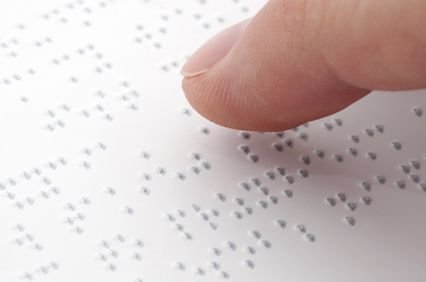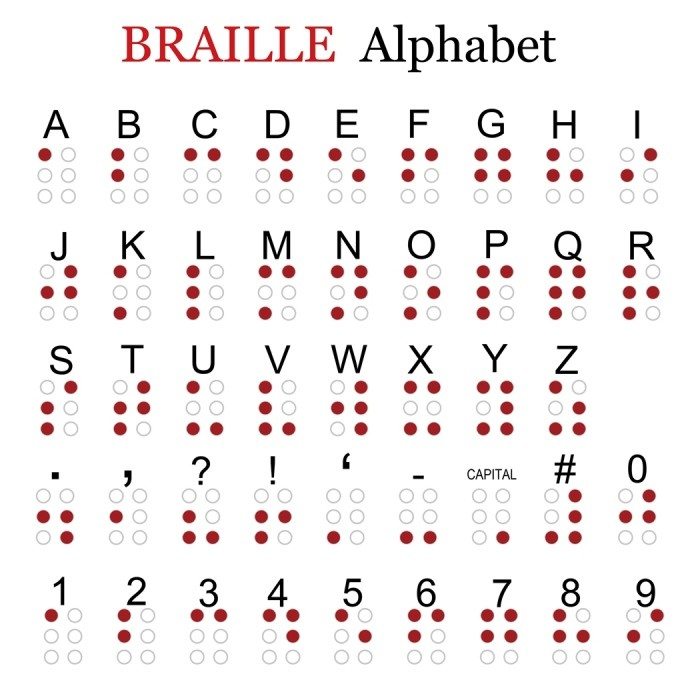Braille
Braille

Braille is a high-pitched tactile writing system for the use of blind or visually impaired people. The system bears the name of its inventor, the Frenchman Louis Braille (1809-1852) who lost his sight following an accident.
A document that is not written in Braille and is not readable by a blind person is called "black" or "black" (a black book, for example).
Louis Braille, born in 1809 became blind at the age of three. In 1819 he joined the Royal Institute of the Blind, two years later he attended the presentation of the sonography made by Barbier. Nicolas-Charles-Marie Barbier La Serre born May 18, 1767 in Valenciennes and died April 29, 1841 is an officer of the French army known for inventing a method of writing sounds in relief: the sonography.
Barbier had to improve his system but did not finally do it, so Louis Braille undertook this work alone. He keeps the basics of the Barbier system, including the principle of coding and the use of highlights.
Most of the system was developed in 1825, Braille was then 16 years old and published his first treaty in 1829.
In standard Braille, a character is represented in a matrix of six points on two columns, each character being formed by one to six points in relief. These points are conventionally numbered from top to bottom and from left to right.

For example, the letter c is represented by the two upper points, that is, the combination 1.4. This system can represent up to 63 characters, a matrix without any point representing a space.
The meaning of each symbol depends on the language used, which explains why Japanese, Korean, Cyrillic and other Braille differ from French Braille. Languages using the Latin alphabet most often use the same encoding for base letters, but accented letters, other symbols, and sometimes punctuation characters differ.
Numbers
![bra2[1].gif](https://steemitimages.com/0x0/https://steemitimages.com/DQmamYGo6Xd57pFsPqt9dkom3FZ7e58LUcv6SK29GxqvQqX/bra2%5B1%5D.gif)
With the request of Napoleon, the system developed by Charles Barbier to allow troops to negotiate in the darkness without light. Although this system was rejected by the military, Charles Barbier met Louis Braille in 1821 when he visited the blind section of the Paris National Institute. Braille said that Barbier's greatest minus is that the representative letters of his alphabet can not be understood unless he moves his finger. This meeting was not able to pass quickly from one symbol to another. Braille produced the alphabet, which would then take his name as a result of his work as a revolutionary. @lndesta120282
Amazing Steemit world, Author get $114.59 with @cheetah warning , my question where should go Original writer
for high Rewards?
cheetah warning is an error...
Wow 😮 I did not know the story
Very nice...
As you mentioned "Braille is a high-pitched tactile writing system for the use of blind or visually impaired people" Yes my Professor in university told me about this. Thanks for sharing such informative post.
Braille texts can also be written faster by using the six-key special braille text corresponding to the six points on the Braille .
This is perfect.. @lndesta120282
I've read about this kind of text a long time ago, it's really what helps ripples and visually impaired people ... I see a huge benefit in this kind of text ... But I hope in the future technology will make even a blind person - seeing ..
Thanks you)
Congratulations, your post received one of the top 10 most powerful upvotes in the last 12 hours. You received an upvote from @glitterfart valued at 109.05 SBD, based on the pending payout at the time the data was extracted.
If you do not wish to receive these messages in future, reply with the word "stop".
nice blog sir
thanks for this
have a nice day
very nice bro